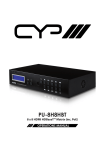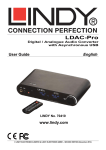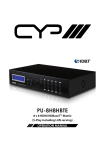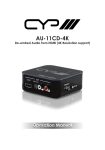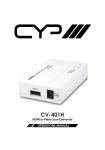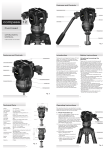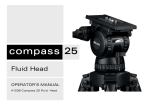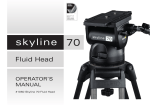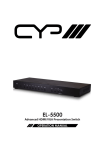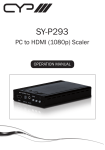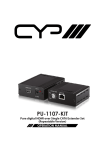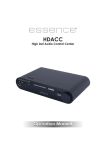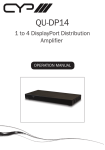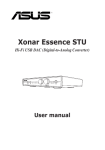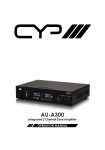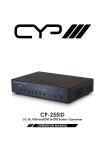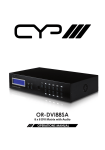Download CYP AU-D250 Specifications
Transcript
AU-D250 Advanced DAC with HDMI Bypass and Audio Breakout OPERATIONS MANUAL DISCLAIMERS The information in this manual has been carefully checked and is believed to be accurate. CYP (UK) Ltd assumes no responsibility for any infringements of patents or other rights of third parties which may result from its use. CYP (UK) Ltd assumes no responsibility for any inaccuracies that may be contained in this document. CYP (UK) Ltd also makes no commitment to update or to keep current the information contained in this document. CYP (UK) Ltd reserves the right to make improvements to this document and/or product at any time and without notice. COPYRIGHT NOTICE No part of this document may be reproduced, transmitted, transcribed, stored in a retrieval system, or any of its part translated into any language or computer file, in any form or by any means—electronic, mechanical, magnetic, optical, chemical, manual, or otherwise—without express written permission and consent from CYP (UK) Ltd. © Copyright 2011 by CYP (UK) Ltd. All Rights Reserved. Version 1.1 August 2011 TRADEMARK ACKNOWLEDGMENTS All products or service names mentioned in this document may be trademarks of the companies with which they are associated. SAFETY PRECAUTIONS Please read all instructions before attempting to unpack, install or operate this equipment and before connecting the power supply. Please keep the following in mind as you unpack and install this equipment: • Always follow basic safety precautions to reduce the risk of fire, electrical shock and injury to persons. • To prevent fire or shock hazard, do not expose the unit to rain, moisture or install this product near water. • Never spill liquid of any kind on or into this product. • Never push an object of any kind into this product through any openings or empty slots in the unit, as you may damage parts inside the unit. • Do not attach the power supply cabling to building surfaces. • Use only the supplied power supply unit (PSU). Do not use the PSU if it is damaged. • Do not allow anything to rest on the power cabling or allow any weight to be placed upon it or any person walk on it. • To protect the unit from overheating, do not block any vents or openings in the unit housing that provide ventilation and allow for sufficient space for air to circulate around the unit. REVISION HISTORY VERSION NO. DATE SUMMARY OF CHANGE v1.01 First release 18/03/13 CONTENTS 1. Introduction�������������������������������������������6 2. Applications�������������������������������������������6 3. Package Contents����������������������������������6 4. System Requirements���������������������������6 5. Features��������������������������������������������������7 6. Operation Controls and Functions�������9 6.1 Front Panel��������������������������������������������������� 9 6.2 Rear Panel���������������������������������������������������10 6.3 Top Panel����������������������������������������������������11 6.4 Remote Control����������������������������������������11 6.5 OLED Menu������������������������������������������������12 7. Connection Diagram�������������������������� 13 8. Specifications�������������������������������������� 14 9. Acronyms��������������������������������������������� 15 1. INTRODUCTION The AU-D250 is designed to integrate and convert both analogue and digital audio signals into any AV system. This device has an in-built sample rate converter which can upscale audio signals between 44.1kHz to 192kHz (24 bit). With HDMI connectivity, allowing the user to embed or de-embed audio within the HDMI signal path, the AU-D250 not only provides a truly enhanced listening experience, but also the flexibility to manage all audio signals in your AV system. For professionals the Ti TPA6120A2 headphone amplifier, XLR (Low noise Professional Balanced output) and 6.3mm headphone jack (3.5 mini-jack adaptor supplied) offer unparalleled audio quality. With a highly accurate PLL and low jitter reduction clock system and an OLED display and IR remote for controlling the device, the AU-D250 is an incredibly useful tool for getting the most out of your audio devices. 2. APPLICATIONS Advanced DAC with Multiple input/output Audio format and sampling rate conversion Professional audio system integration with XLR balanced outputs MAC/PC audio output to professional speakers/headphones Analogue to digital or digital to analogue audio conversion HDMI audio embedding or de-embedding 3. PACKAGE CONTENTS Advanced DAC with HDMI Bypass and Audio Breakout 1×Remote Control (with battery) 6.5mm to 3.5mm phone jack adaptor 5 V/3.6 A DC Power adaptor Operation Manual 4. SYSTEM REQUIREMENTS Input source equipment such as PC (USB) or DVD player with relevant connection cables and output to amplifier, active speakers or headphones 6 5. FEATURES Main 6 Input, 6 Output Advanced DAC 4 Digital Inputs, 2 Analogue Inputs 3 Digital Outputs, 2 Analogue Outputs and Headphone Output Full system control from IR remote or main control dial via OLED display. Digital HDMI, USB, Optical and Coaxial digital audio inputs support LPCM stereo HDMI input supports LPCM stereo in all modes but can pass surround sound signal whilst in bypass mode All digital inputs support 192kHz sampling rate at up to 24-bit resolution HDMI, Optical and Coaxial digital outputs All digital inputs can be SRC (Sample Rate Conversion) to 44.1, 48, 88.2, 96, 176.4 and 192 kHz via DSP Engine (Digital Signal Processing) Highly accurate PLL and low jitter reduction clock system HDMI Audio output (video is always bypassed to HDMI output) can either output the incoming HDMI (HDMI Bypass Mode) or embed the selected audio signal (HDMI Input Mode) Analogue Built-in Ti TPA6120A2 high quality headphone amplifier output Professional XLR balanced stereo output RCA analogue stereo output RCA analogue stereo input Mini-jack (3.5mm) stereo input Total Harmonic Distortion (THD): Less than 100dB (-20dBFS) Analogue inputs provide digital output sampling rates up to 192 kHz 7 Misc IR Remote with direct source, power and mute buttons HDMI audio embedding or de-embedding Volume control of analogue and headphone outputs or just headphone output via remote or main control dial Direct power and mute button on unit High viewing angle OLED display Headphone output fades in after system is muted 6.3mm headphone output (3.5mm mini-jack adaptor supplied) 8 6. OPERATION CONTROLS AND FUNCTIONS 6.1 Front Panel MENU 1 2 3 4 5 1 6.5mm Headphone Jack: Connect to a 6.5mm professional headphone set for the user to enjoy the individual professional audio sound. 2 3.5mm Front IN: Connect with 3.5mm mini-jack cable from any audio equipment for stereo audio input. 3 IR: IR receiver window, accepts the IR signal from the supplied remote control. 4 OLED: Displays the input/output selection, volume setting, sampling rate and audio channels.. A B C D A. Input Source B. Headphone or analogue line level volume or system mute C. Input sample-rate D. Output sample-rate 5 Menu & Volume controller: Turn to adjust the volume. Press inwards to enter into the menu and turn it to select the desire setting, press again to confirm the selection. Note: The Volume and Mute functions only affect the headphone and analogue line-out volume levels, all other outputs are not affected. 9 6.2 Rear Panel 4 DC 5V COAX. HDMI OUT L USB OPT. OUT HDMI IN 1 2 3 R IN 5 OUT IN 6 XLR OUT R XLR OUT L 7 1 DC 5V: Plug the 5V DC power supply into the unit and connect the adaptor to an AC outlet. 2 HDMI IN/OUT: Connect to a HDMI source such as a satellite box or DVD Audio player and output to a HDMI HDTV/monitor for display output. 3 USB: Connect to a PC/MAC source for USB audio signal input. 4 COAX OUT/IN: Connect the COAX IN to an coaxial digital audio input source such as set-top box or CD Player and the COAX OUT to an amplifier or active speakers with a coaxial cable. 5 OPT. OUT/IN: Connect the OPT. IN to an optical digital audio input source such as a DVD/Blu-ray player or PS3 and the OPT. OUT to an amplifier or active speakers with an optical cable. 6 L/R IN/OUT: Connect the L/R IN to an analogue stereo input source such as a CD Player or media player and the L/R OUT to amplifier or active speakers with RCA jack cable. 7 R/L XLR OUT(Balanced): XLR L/R OUT: Connect to an amplifier with balanced XLR inputs or directly to professional balanced equipment with XLR cables Note: HDMI Input mode: In this mode, whatever audio input is selected will be routed to the HDMI output as well as all other outputs. HDMI Bypass mode: In this mode HDMI video and audio will always be routed to the HDMI output no matter what input is selected, whilst all other outputs will output the audio from the selected input. This function allows the user to have two distinct audio pathways throught the unit. 10 6.3 Top Panel 1 2 1 POWER: Press this button to switch on the device or set to standby mode. 2 MUTE: Press this button to mute or unmute the audio volume instantly. 6.4 Remote Control 1 POWER: Press this button to turn On or to set the device in standby mode. 1 2 MUTE: press this button to mute or unmute the audio volume instantly. 3 3 VOL. Up/Down: Press these buttons to turn up or down on the output audio volume. 4 MENU: Press these button to enter into the menu selections then press the up/ down buttons to select and press it again to confirm the selection. 2 4 5 6 5 RETURN: Press this button to return or exit the menu selection. 6 INPUT: Press these hot keys to switch the input sources instantly. 11 6.5 OLED Menu 1ST LAYER FULL NAME 2ND LAYER Source In Source Selection HDMI In USB In Optical In Coaxial In Line In (L/R In) Front In Return SRC Set Sampling Rate Conversion Setup Bypass 192 kHz 176.4 kHz 96 kHz 88.2 kHz 48 kHz 44.1 kHz Return HDMI TX Set HDMI Output Setup Bypass Input Return Display Set Display Time Out Setup TimeOut 5s TimeOut 10s TimeOut 15s Return HP Impedance Headphone Impedance 16 Ω 32 Ω 64 Ω 200 Ω 300 Ω 600 Ω Return Line Out Set Headphone/Line Out Setup Fix Level Volume Level Return Reset to Default OK Return Return 12 7. CONNECTION DIAGRAM Headphones Headphone Output FRONT MENU Line-level Input Smartphone or MP3 Player Display Mac PC Set-top Box USB Input Digital Audio Input CD Player Stereo Analogue Input HDMI Output DC 5V Power Supply COAX. HDMI OUT L USB OPT. HDMI IN HDMI Input DVD/CD Player OUT R IN IN OUT Digital Audio Output XLR OUT R XLR OUT L REAR Stereo Analogue Output XLR Balanced Output AV Receiver or Stereo Amplifier Active Speakers 13 8. SPECIFICATIONS Input Ports 1×HDMI, 1×USB (Type B), 1×Coaxial, 1×Optical, 1×L/R (Analogue Stereo 2RCA), 1×3.5mm Phone Jack (L/R) Output Ports 1×HDMI, 1×Coaxial, 1×Optical, 1×L/R (Analogue Stereo 2RCA), 1×XLR (Balanced Analogue Stereo), 1×6.3mm Phone Jack (Headphone) Digital Audio I/O Support LPCM 2CH Stereo Audio I/O Level 2 Vrms ±0.2 XLR Blanced I/O Level 4 Vrms ±0.2 Headphone Impedance 16 Ω ~ 600 Ω ESD Protection Human body model: ±8 kV (air-gap discharge) ±6 kV(contact discharge) Power Supply 5 V/3 A DC (US/EU standards, CE/FCC/UL certified) Dimensions 138 mm (W)×223 mm (D)×50 mm (H) Weight 680 g Chassis Material Aluminum Colour Black Power Consumption 15 W 9. ACRONYMS ACRONYM COMPLETE TERM COAX Coaxial HD High Definition HDMI High-Definition Multimedia Interface OLED Organic Light-Emitting Diode OPT Optical PLL Phase Locked Loop SRC Sample Rate Conversion THD Total Harmonic Distortion CYP (UK) Ltd., Unit 7, Shepperton Business Park, Govett Avenue, Shepperton, Middlesex, TW17 8BA Tel: +44 (0) 20 3137 9180 | Fax: +44 (0) 20 3137 6279 Email: [email protected] www.cypeurope.com v1.01

















